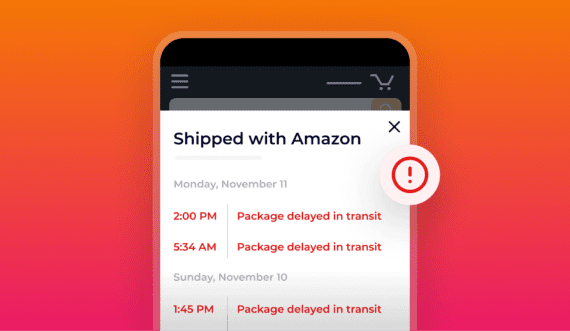Table of Contents
Why is Amazon keyword research so important for sellers?
How does Amazon’s search algorithm work?
Where are keywords most important on Amazon?
Understanding different types of Amazon keywords
How to conduct and implement Amazon keyword research like a pro
Common mistakes in Amazon keyword research and how to avoid them
Content
expand_moreTable of Contents
Why is Amazon keyword research so important for sellers?
How does Amazon’s search algorithm work?
Where are keywords most important on Amazon?
Understanding different types of Amazon keywords
How to conduct and implement Amazon keyword research like a pro
Common mistakes in Amazon keyword research and how to avoid them
Keywords and search terms are central to how Amazon picks which products to show shoppers. Used properly, this tactic can help sellers optimize their product listings, which improves product visibility and increases rankings in Amazon search (a kind of Amazon SEO).
But finding the best keywords for every single product you offer can be pretty time-consuming — and it sometimes feels like you’re throwing darts in the dark, never quite sure the quality of your results.
In this guide we’ll show you exactly how to conduct Amazon keyword research and start improving your keyword rankings in Amazon’s search engine.
Why is Amazon keyword research so important for sellers?
Keyword research is vital for Amazon sellers for one simple, foundational reason:
To sell a product on Amazon, you need people to see or find that product on Amazon.
If we extend that concept a bit, then to sell more products, you need more people (and the right kinds of people) to see it.
Keyword research is one of the most significant ways to increase how many right-fit shoppers see your product on page one of their Amazon search results.
Many people tend to think of Amazon as just an ecommerce website. But Amazon is just as much a search engine as it is an online store (in fact, it’s the search engine of choice for half of all online shopping searches). It’s a complex algorithm that tries to match searchers with satisfying results.
You’re already selling products that those searchers want (or you will be soon). Keyword research helps you determine what those searchers are actually searching for (customer search intent) and the terms they’re using (keywords), so you can adjust your product listings accordingly.
What does this mean in terms of ROI?
Keyword research is a relatively small and inexpensive adjustment to make, building on top of your existing workflows for identifying, sourcing, and listing products. Yet this small adjustment often leads to a significantly higher return on investment (ROI).
Why? Because proper keyword research drives larger volumes of more relevant traffic to your products. And when more (and more relevant) users see your products, more of them click “add to cart” and your conversion rate climbs.
By researching and then using more targeted keywords in your Amazon listings, you’ll encourage better customer engagement and higher conversion rates — and you’ll also frequently lower your ad costs, too. By using an Amazon keyword research tool like Jungle Scout, you can identify relevant high-volume, low-competition keywords that cost less but perform well.
How does Amazon’s search algorithm work?
Amazon doesn’t share much information directly about its search algorithm, but through trial, error, and data-driven analytics, we know quite a bit about how it works.
Amazon’s latest iteration of its search algorithm is known as the A10 algorithm. It replaced the longstanding A9 product ranking algorithm back in 2021. Both versions scour nearly every element associated with a product listing in order to understand what products are and then match searchers (and search intent) to the best possible results. A10 goes even further, evaluating data from outside the Amazon ecosystem (such as social media mentions and traffic that originated elsewhere, like Google searches, etc.). 
A10 also weighs seller authority (a separate calculation involving how long a seller has been active on Amazon, how many products they offer, number of sales, and feedback and ratings) as one ranking factor.
To show you in greater detail how Amazon’s search algorithm works, let’s look at a few of the most important elements of Amazon’s search algorithm.
Amazon search box
First up is the search box itself. It’s easy to overlook this element as, well, just a box — but this little box is much more than just a box.
Yes, it’s the place where people enter their search terms. But, just like Google tries to autocomplete your searches, the Amazon search box tries to guess what a user is trying to search for.
When users search for keywords, the search box retrieves relevant product listings. By using common keywords that relate to your product, you’ll improve product visibility because over time your Amazon search rankings placements will likely improve.
Side note: This can be a low-tech way of doing basic keyword research. Imagine you sell iPhone cases, for example. Head over to that search bar and type in “iPhone ca” — don’t finish the word. Looking at the keywords and phrases that show up as possible autocompletes will show you some keywords you should probably be using on relevant listings.
Search filters
Searches for common products can get a little cluttered these days, so some searchers will use filters to narrow down their search results.
Making sure your products are appropriately listed in the right product categories will help you survive the filter purge. Keywords matter here as well: for a product type where color is an available filter, you want your blue items to show up under the “blue” filter, and so on.
Search results page
The exact way products are ranked on the search results page is opaque. No one outside of Amazon knows exactly how these are calculated. (Neither do most people inside Amazon.)
But we do know that keyword relevance, prior sales performance, and conversion rate are each major factors. Seller authority, ratings and reviews, and even off-site mentions and activity all carry some weight as well.
Bid amount is another factor for sponsored products and listings — more on this later on.
The important takeaway here is that only some of these elements are directly within your control. The biggest of these is keyword research and optimization. Using the right keywords the right way will improve both organic ranking and paid placements.
Amazon sales rank
A product’s Amazon sales rank is a calculation of a product’s performance. It seems to involve both number of units sold and conversion rate (how many people bought the product after reaching the page via the given search term).
Remember, Amazon wants to sell products, and it wants to keep its users happy. So imagine that a specific phone case has already sold extremely well and converted well off of a specific keyword search. Amazon is motivated to show that same item to others searching that same term, so it climbs higher in search results (or stays at the top if already there).
Showing up higher in search results means greater visibility and higher levels of trust with customers. Maybe they haven’t heard of the case brand before, but if it’s #1 on Amazon, surely it’s decent — right?
This aspect can feel a bit like a chicken-and-egg situation: Amazon sales rank is influenced by product sales and performance, but then sales and performance improve when the Amazon sales rank improves.
Sponsored products and advertising
Sponsored products and other advertising options work differently. With these, sellers can bid on specific keywords to achieve higher placement (sometimes even top placement) in search results.
There’s a lot of nuance here, but for now, we’ll keep it brief: because of this bid system, some keywords are much more expensive than others. The more sellers that want to compete on a keyword, the higher the bids for that keyword will go.
Plus, with A10, it seems like Amazon now considers search terms from sponsored campaigns as another ranking factor.
Using the right keywords in Amazon PPC campaigns can help sellers appear in more searches and increase sales. But because of the bid system, there’s a lot of strategy that goes into which keywords are the right keywords for a given product listing.
Sellers who can find those mythical keywords with a high keyword search volume and low competition (low cost) can stretch their PPC spend much farther than those who aim only for the most obvious (high competition) keywords.
Where are keywords most important on Amazon?
Choosing the right keywords is the crucial first step, but nearly as important is using those keywords in the right places.
Amazon product listings work a little differently than standard web pages in terms of optimization. Various parts of the listing can affect the success of that listing in differing ways, and Amazon’s search algorithm seems to weigh them differently.
Each of the following content areas or fields can improve a product listing in one or more of these ways:
- Ranking
- Visibility
- Click-through rate (CTR)
- Conversion
Product title
First is the product title. Incorporating relevant keywords into the product title leads to better search visibility.
This may sound obvious, but it’s a big point of departure from traditional retail — which means it can be easily overlooked.
Here’s what we mean: if you walk into an office supply store looking for a new office chair, it’s patently obvious where to go (and that all the chairs you’re standing in front of are in fact chairs meant for an office). Not every tag or sign has to explicitly state that a chair is a “leather rolling office chair suitable for up to 300 pounds with 5 points of adjustment.” In fact, you wouldn’t really ever want the IRL product title to be that long.
But this isn’t how things work in ecommerce (and on Amazon specifically). Here you do want a number of those terms in the product title itself — because putting them there helps humans and algorithms alike quickly identify that the chair has the attributes the user wants.
Quick tip: Keep your titles readable in natural language, and avoid keyword stuffing. A quick rule of thumb is “does this sound like how humans talk?”
Product details
The Product details section is next up. Here’s where all the relevant keywords that didn’t fit into the product title should go. Here again, use them naturally in your copy. Don’t forget to include them in bullet points and descriptions!
The primary goal should be to provide customers with relevant information. Once that’s done, then review that content for any keyword opportunities you may have missed.
Operating this way helps sellers to maintain clarity in their listing and avoid looking like blatant keyword stuffing, which could get you penalized in search.
Quick tip: Use tools to simplify and speed up this part of the process. Jungle Scout’s Listing Builder is a great option.
Seller Central (backend search)
You may at this point have keywords from your keyword research that you haven’t been able to work naturally into copy. Or, in certain cases, you may want to include keywords that don’t visibly appear in your listing.
In Amazon Seller Central, you can do this using backend keywords. Under the “keywords” tab you can add additional keywords that Amazon’s algorithm will consider but that don’t appear on your listing.
We’ve found in our research that Amazon weighs these heavily, so it’s a great idea to include keywords that didn’t make the cut. Consider common misspellings, synonyms for your main keyword, and related or near-match keywords.
Amazon provides five fields and indexes roughly the first 50 characters in each (250 characters in total), so try to divide your terms evenly.
Here’s an example. You may want to go after variant spellings (like U.S. vs U.K. spellings) or near-match keywords (like “cellular phone case” or “phone case”), but you don’t want your listing to contain inconsistencies, apparent misspellings, or dated language. Include these kinds of terms as backend or hidden keywords to get some consideration for those keywords without using them in the user-facing copy.
Bullet points
Next, consider your keyword usage within the listing’s bullet points.
There’s a reason you see bullet points in nearly every form of digital content:
- Bullet points draw the eyes in
- Bullet points help readers identify important information
- Bullet points provide logical, visual structure
Since readers will naturally gravitate toward your listing’s bullet points, Amazon may weigh these more heavily than other sections. So here you want to use keywords strategically within your bullet points — both to orient your human readers and to help the algorithm understand what your product is.
On the human side, potential buyers often expect bullet points to clearly identify product features. Using specific and relevant keywords here (including those related to specific features) can improve both search visibility and conversions.
Understanding different types of Amazon keywords
Keyword research and optimization for Amazon listings can get pretty granular — we know it can be a lot to sort through.
Thinking through the different types or categories of keywords can help to narrow your focus.
Short-tail vs. long-tail keywords

Short-tail keywords are broad, general, and (yes) usually short keywords. For example:
- “phone case”
- “water bottle”
- “keyboard”
- “toothpaste”
Long-tail keywords are more specific, more targeted, and longer. Here’s one long-tail keyword for each of the above:
- “leather case for iPhone SE”
- “aluminum water bottle with straw”
- “ergonomic mechanical keyboard”
- “charcoal toothpaste for kids”
Short-tail keywords have higher search volume and heavier competition. If you can win on one of them, you’ll win a lot of searches. But winning on something like “phone case” isn’t easy if you’re not already a big brand.
Long-tail keywords have lower search volume and lower competition — but they’re also much more specific. If someone wants to pick up charcoal toothpaste for their kids, they’re likely going to ignore 98% of search results for “toothpaste.” They’re going to pay attention to nearly every (top) search result for the long-tail version.
So which should you use? It depends on your selling goals. Long-tail keywords bring in less but much more targeted traffic, and they’re much cheaper for PPC. Short-tail keywords can bring in tons of traffic, but only if you win.
Branded vs. non-branded keywords
Branded keywords include a branded or trademarked term (iPhone, HydroFlask, Razer, Crest), while non-branded keywords don’t (smartphone, water flask, keyboard, toothpaste).
If you’re selling branded products (or products that work specifically with branded products), then you want to include a mix of both branded and non-branded keywords. Some searchers know and care about that brand name, while others don’t. Using both types means capturing both types of searchers.
How to conduct and implement Amazon keyword research like a pro
So far we’ve covered a lot of ground on how Amazon’s algorithm interprets keywords and how to use them in your product listings.
But there’s still an unanswered question: How do you determine — with confidence — which keywords to use?
Now it’s time to find out how to conduct keyword research, find the winning keywords for a product, and use that information to optimize your Amazon product listings.
1. Use Jungle Scout’s Keyword Scout tool
Start with Jungle Scout’s Keyword Scout tool. This powerful tool pulls from millions of data points, providing users with actionable information about any keyword imaginable. You can use it to discover which keywords related to a product are both high-ranking and high-converting, helping you focus and fine-tune your listings.
Keyword Scout can show you all relevant keywords related to your base short-tail keyword, and it identifies search volume (both exact match search volume and broad match search volume) and competition level for each. With this tool, you can quickly identify the keywords with higher search volume and lower competition — these are the most important ones to target in most situations.
You can also reverse ASIN search to look up products and view those associated keywords, and then add them to groups/lists to track. This way you can pull up specific products and items, not just keywords. With reverse ASIN search, you can compare and study related keywords (both organic and sponsored), identifying what’s working well for the competition.
Powerful filters help you focus your keyword research, cutting through the noise and pointing you to the right keywords for a given product. Keyword Scout also shows you recommended bid amounts for PPC, helping you target keywords with the right volume and cost for your budget.
Keyword Scout even tracks seasonal trends in keyword performance. This is vital for understanding how to work with keywords related to seasonal (e.g., holiday or weather-dependent) items, which will spike and dip in popularity at certain points in the year. 
2. Analyze competitor listings
Next, it pays to learn what’s already working for the competition. This is key for new product launches, and it can also produce results when refreshing or optimizing a poorly performing listing.
Keyword Scout helps here, too. You can compare your item with top competitors, and you can also identify which keywords your competitors are winning and which are driving the most traffic to those competitors.
Seeing where you rank for these same keywords can help you refine your listings. You might also discover high-performing keywords you’re missing entirely!
Check out our step-by-step guide on competitor analysis for Amazon sellers, and established brands can dive even deeper into benchmarks and AI driven analysis with Competitive Intelligence.
3. Track keyword performance over time
Shoppers (and the algorithms that lead them to your products) are constantly changing, which means there’s no resting on current or past success. Winning the keyword battle requires tracking those keywords over time and identifying changes in performance and search behavior.
Tracking keyword performance over time can alert you to improvements your competitors have made, or to the possibility that there are new keywords for a given product that need to be added to the listing.
Jungle Scout’s Rank Tracker tool can help with this, giving a clear view of which keywords are driving traffic and which may need adjustments to improve visibility.
4. Identify niche markets for new keyword opportunities
Ecommerce is all about opportunity: be the first to find a new one, and you’ll be several steps ahead of the competition.
Jungle Scout’s Opportunity Finder tool helps sellers discover high-demand, low-competition niches by analyzing keyword trends and product opportunities. It’s a great way to find new audiences and use cases for existing products — and to identify underserved markets where new products can break through.
Common mistakes in Amazon keyword research and how to avoid them
Amazon keyword strategy is complex and sometimes evolves quickly, so it’s easy to make mistakes. Here are a few we see frequently, and what to do instead:
Keyword stuffing
Keyword stuffing is the practice of including obnoxious numbers of keywords (often including irrelevant ones) on a web page (or even in its metadata) for the purpose of capturing more search traffic.
Decades ago, this tactic was used all over the internet: low-quality content with just pages and pages of spammy keywords.
While it’s not gone completely, it’s a tactic discouraged by most modern search engine algorithms, and Amazon has publicly stated it discourages keyword stuffing through lower rankings.
Beyond being a low-effort way to try to cheat the system, keyword stuffing annoys your customers. They don’t want to read unintelligible, spammy-sounding product descriptions, and they definitely don’t want to land on a product page that has nothing to do with what they’re trying to buy.
Instead, write readable copy and place keywords naturally throughout. (Not sure how to scale your writing? Try an AI-powered boost to creating product listings.)
Ignoring long-tail keywords
Short-tail keywords might be the biggest bounty, but don’t ignore those long-tail keywords. Unless you’re already a big brand, winning short-tail keywords is tough. Plus, PPC bids can get painfully expensive!
Long-tail keywords don’t bring in as much traffic, but the traffic they bring in is far more targeted. If you’ve chosen the right long-tail keywords for a product, this translates into much higher conversion rates.
Failing to update keywords regularly
Keyword trends change over time, and so does search behavior. The keywords that are performing well today may not do so in six months or a year, so make sure you track keyword performance and update your listings regularly using a tool like Jungle Scout’s Rank Tracker.
Rank Tracker helps sellers better understand their performance relative to the competition so they can identify when it’s time to make listing improvements to stay competitive.
Master your Amazon keyword strategy with Jungle Scout
As an Amazon seller, you want to reach more shoppers, rank higher, and sell more. What’s the key skill that unlocks all three (and more)? Mastering Amazon keyword research.
With the right tools and skills in place, you’ll be better positioned to identify strategic keywords, implement them properly, and then monitor their performance over time so you can update product listings when needed.
Jungle Scout’s suite of tools, including Keyword Scout, Rank Tracker, and Opportunity Finder, helps sellers of all sizes improve their rankings, grow their sales, and achieve long-term success. With Jungle Scout, you can greatly simplify the keyword research process and gain valuable insights into your and competitors’ keywords. Jungle Scout makes it possible to grow your Amazon business and become (and stay) competitive.
Ready to take control of your keyword research? Get started with Jungle Scout today!









